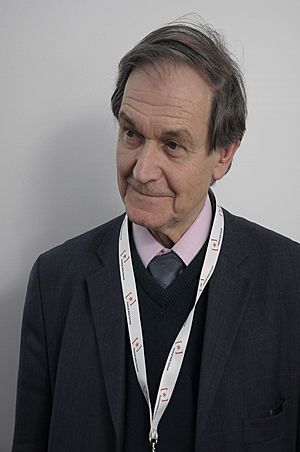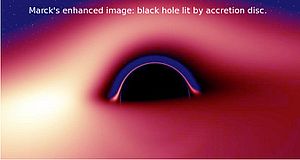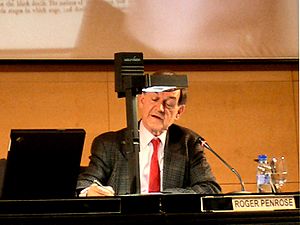Roger Penrose facts for kids
Quick facts for kids
Sir Roger Penrose
|
|
|---|---|

Penrose in 2011
|
|
| Born | 8 August 1931 Colchester, Essex, England
|
| Education | |
| Known for |
List of contributions
Moore–Penrose inverse
Twistor theory Spin network Abstract index notation Black hole bomb Geometry of spacetime Cosmic censorship Illumination problem Weyl curvature hypothesis Penrose inequalities Penrose interpretation of quantum mechanics Diósi–Penrose model Newman–Penrose formalism GHP formalism Penrose diagram Penrose inequality Penrose process Penrose tiling Penrose triangle Penrose stairs Penrose–Hawking singularity theorems Penrose graphical notation Penrose transform Penrose–Terrell effect pp-wave spacetime Schrödinger–Newton equations Orch-OR/Penrose–Lucas argument FELIX experiment Trapped surface Andromeda paradox Conformal cyclic cosmology |
| Spouse(s) |
Joan Isabel Wedge
(m. 1959, divorced)Vanessa Thomas
(m. 1988) |
| Children | 4 |
| Relatives | Lionel Penrose (father), Roland Penrose (uncle), Jonathan Penrose (brother), Oliver Penrose (brother), Shirley Hodgson (sister), Antony Penrose (cousin) |
| Awards |
List of awards
Adams Prize (1966)
Heineman Prize (1971) Fellow of the Royal Society (1972) Eddington Medal (1975) Royal Medal (1985) Wolf Prize (1988) Dirac Medal (IOP) (1989) Albert Einstein Medal (1990) Naylor Prize and Lectureship (1991) Knight Bachelor (1994) James Scott Prize Lectureship (1997–2000) Karl Schwarzschild Medal (2000) De Morgan Medal (2004) Dalton Medal (2005) Copley Medal (2008) Fonseca Prize (2011) Nobel Prize in Physics (2020) |
| Scientific career | |
| Fields | Mathematical physics, tessellations |
| Institutions | |
| Thesis | Tensor Methods in Algebraic Geometry (1957) |
| Doctoral advisor | John A. Todd |
| Other academic advisors | W. V. D. Hodge |
| Doctoral students |
|
Sir Roger Penrose (born 8 August 1931) is an English mathematician, mathematical physicist, philosopher of science and Nobel Laureate in Physics. He is Emeritus Rouse Ball Professor of Mathematics in the University of Oxford, an emeritus fellow of Wadham College, Oxford, and an honorary fellow of St John's College, Cambridge, and University College London.
Penrose has contributed to the mathematical physics of general relativity and cosmology. He has received several prizes and awards, including the 1988 Wolf Prize in Physics, which he shared with Stephen Hawking for the Penrose–Hawking singularity theorems, and the 2020 Nobel Prize in Physics "for the discovery that black hole formation is a robust prediction of the general theory of relativity".
Contents
Early life and education
Born in Colchester, Essex, Roger Penrose is a son of physician Margaret (née Leathes) and psychiatrist and geneticist Lionel Penrose. His paternal grandparents were J. Doyle Penrose, an Irish-born artist, and The Hon. Elizabeth Josephine Peckover, daughter of Alexander Peckover, 1st Baron Peckover; his maternal grandparents were physiologist John Beresford Leathes and Sonia Marie Natanson, a Russian Jew. His uncle was artist Sir Roland Penrose, whose son with American photographer Lee Miller is Antony Penrose. Penrose is the brother of physicist Oliver Penrose, of geneticist Shirley Hodgson and of chess Grandmaster Jonathan Penrose. Their stepfather was the mathematician and computer scientist Max Newman.
Penrose spent World War II as a child in Canada where his father worked in London, Ontario at the Ontario Hospital and Western University. Penrose studied at University College School. He then attended University College London, where he obtained a BSc degree with First Class Honours in mathematics in 1952.
In 1955, while a doctoral student, Penrose reintroduced the E. H. Moore generalised matrix inverse, also known as the Moore–Penrose inverse, after it had been reinvented by Arne Bjerhammar in 1951. Having started research under the professor of geometry and astronomy, Sir W. V. D. Hodge, Penrose received his PhD in algebraic geometry at St John's College, Cambridge in 1957, with his thesis titled "Tensor Methods in Algebraic Geometry" supervised by algebraist and geometer John A. Todd. He devised and popularised the Penrose triangle in the 1950s in collaboration with his father, describing it as "impossibility in its purest form", and exchanged material with the artist M. C. Escher, whose earlier depictions of impossible objects partly inspired it. Escher's Waterfall and Ascending and Descending were in turn inspired by Penrose.
As reviewer Manjit Kumar puts it:
As a student in 1954, Penrose was attending a conference in Amsterdam when by chance he came across an exhibition of Escher's work. Soon he was trying to conjure up impossible figures of his own and discovered the tribar – a triangle that looks like a real, solid three-dimensional object, but isn't. Together with his father, a physicist and mathematician, Penrose went on to design a staircase that simultaneously loops up and down. An article followed and a copy was sent to Escher. Completing a cyclical flow of creativity, the Dutch master of geometrical illusions was inspired to produce his two masterpieces.
Research and career
Penrose spent the academic year 1956–57 as an assistant lecturer at Bedford College (now Royal Holloway, University of London) and was then a research fellow at St John's College, Cambridge. During that three-year post, he married Joan Isabel Wedge, in 1959. Before the fellowship ended Penrose won a NATO Research Fellowship for 1959–61, first at Princeton and then at Syracuse University. Returning to the University of London, Penrose spent 1961–63 as a researcher at King's College, London, before returning to the United States to spend 1963–64 as a visiting associate professor at the University of Texas at Austin. He later held visiting positions at Yeshiva University, Princeton and Cornell during 1966–67 and 1969.
In 1964, while a reader at Birkbeck College, London, (and having had his attention drawn from pure mathematics to astrophysics by the cosmologist Dennis Sciama, then at Cambridge) in the words of Kip Thorne of Caltech, "Roger Penrose revolutionised the mathematical tools that we use to analyse the properties of spacetime". Until then, work on the curved geometry of general relativity had been confined to configurations with sufficiently high symmetry for Einstein's equations to be solvable explicitly, and there was doubt about whether such cases were typical. One approach to this issue was by the use of perturbation theory, as developed under the leadership of John Archibald Wheeler at Princeton. The other, and more radically innovative, approach initiated by Penrose was to overlook the detailed geometrical structure of spacetime and instead concentrate attention just on the topology of the space, or at most its conformal structure, since it is the latter – as determined by the lay of the lightcones – that determines the trajectories of lightlike geodesics, and hence their causal relationships. The importance of Penrose's epoch-making paper "Gravitational Collapse and Space-Time Singularities" (summarised roughly as that if an object such as a dying star implodes beyond a certain point, then nothing can prevent the gravitational field getting so strong as to form some kind of singularity) was not its only result. It also showed a way to obtain similarly general conclusions in other contexts, notably that of the cosmological Big Bang, which he dealt with in collaboration with Sciama's most famous student, Stephen Hawking.
It was in the local context of gravitational collapse that the contribution of Penrose was most decisive, starting with his 1969 cosmic censorship conjecture, to the effect that any ensuing singularities would be confined within a well-behaved event horizon surrounding a hidden space-time region for which Wheeler coined the term black hole, leaving a visible exterior region with strong but finite curvature, from which some of the gravitational energy may be extractable by what is known as the Penrose process, while accretion of surrounding matter may release further energy that can account for astrophysical phenomena such as quasars.
Following up his "weak cosmic censorship hypothesis", Penrose went on, in 1979, to formulate a stronger version called the "strong censorship hypothesis". Together with the Belinski–Khalatnikov–Lifshitz conjecture and issues of nonlinear stability, settling the censorship conjectures is one of the most important outstanding problems in general relativity. Also from 1979, dates Penrose's influential Weyl curvature hypothesis on the initial conditions of the observable part of the universe and the origin of the second law of thermodynamics. Penrose and James Terrell independently realised that objects travelling near the speed of light will appear to undergo a peculiar skewing or rotation. This effect has come to be called the Terrell rotation or Penrose–Terrell rotation.
In 1967, Penrose invented the twistor theory, which maps geometric objects in Minkowski space into the 4-dimensional complex space with the metric signature (2,2).
Penrose is well known for his 1974 discovery of Penrose tilings, which are formed from two tiles that can only tile the plane nonperiodically, and are the first tilings to exhibit fivefold rotational symmetry. In 1984, such patterns were observed in the arrangement of atoms in quasicrystals. Another noteworthy contribution is his 1971 invention of spin networks, which later came to form the geometry of spacetime in loop quantum gravity. He was influential in popularizing what are commonly known as Penrose diagrams (causal diagrams).
In 1983, Penrose was invited to teach at Rice University in Houston, by the then provost Bill Gordon. He worked there from 1983 to 1987. His doctoral students have included, among others, Andrew Hodges, Lane Hughston, Richard Jozsa, Claude LeBrun, John McNamara, Tristan Needham, Tim Poston, Asghar Qadir, and Richard S. Ward.
In 2004, Penrose released The Road to Reality: A Complete Guide to the Laws of the Universe, a 1,099-page comprehensive guide to the Laws of Physics that includes an explanation of his own theory. The Penrose Interpretation predicts the relationship between quantum mechanics and general relativity, and proposes that a quantum state remains in superposition until the difference of space-time curvature attains a significant level.
Penrose is the Francis and Helen Pentz Distinguished Visiting Professor of Physics and Mathematics at Pennsylvania State University.
An earlier universe
In 2010, Penrose reported possible evidence, based on concentric circles found in Wilkinson Microwave Anisotropy Probe data of the cosmic microwave background sky, of an earlier universe existing before the Big Bang of our own present universe. He mentions this evidence in the epilogue of his 2010 book Cycles of Time, a book in which he presents his reasons, to do with Einstein's field equations, the Weyl curvature C, and the Weyl curvature hypothesis (WCH), that the transition at the Big Bang could have been smooth enough for a previous universe to survive it. He made several conjectures about C and the WCH, some of which were subsequently proved by others, and he also popularized his conformal cyclic cosmology (CCC) theory. In this theory, Penrose postulates that at the end of the universe all matter is eventually contained within black holes, which subsequently evaporate via Hawking radiation. At this point, everything contained within the universe consists of photons, which "experience" neither time nor space. There is essentially no difference between an infinitely large universe consisting only of photons and an infinitely small universe consisting only of photons. Therefore, a singularity for a Big Bang and an infinitely expanded universe are equivalent.
In simple terms, Penrose believes that the singularity in Einstein's field equation at the Big Bang is only an apparent singularity, similar to the well-known apparent singularity at the event horizon of a black hole. The latter singularity can be removed by a change of coordinate system, and Penrose proposes a different change of coordinate system that will remove the singularity at the big bang. One implication of this is that the major events at the Big Bang can be understood without unifying general relativity and quantum mechanics, and therefore we are not necessarily constrained by the Wheeler–DeWitt equation, which disrupts time. Alternatively, one can use the Einstein–Maxwell–Dirac equations.
Consciousness
Penrose has written books on the connection between fundamental physics and human (or animal) consciousness. In The Emperor's New Mind (1989), he argues that known laws of physics are inadequate to explain the phenomenon of consciousness. Penrose proposes the characteristics this new physics may have and specifies the requirements for a bridge between classical and quantum mechanics (what he calls correct quantum gravity). Penrose uses a variant of Turing's halting theorem to demonstrate that a system can be deterministic without being algorithmic. (For example, imagine a system with only two states, ON and OFF. If the system's state is ON when a given Turing machine halts and OFF when the Turing machine does not halt, then the system's state is completely determined by the machine; nevertheless, there is no algorithmic way to determine whether the Turing machine stops.)
Penrose believes that such deterministic yet non-algorithmic processes may come into play in the quantum mechanical wave function reduction, and may be harnessed by the brain. He argues that computers today are unable to have intelligence because they are algorithmically deterministic systems. He argues against the viewpoint that the rational processes of the mind are completely algorithmic and can thus be duplicated by a sufficiently complex computer. This contrasts with supporters of strong artificial intelligence, who contend that thought can be simulated algorithmically. He bases this on claims that consciousness transcends formal logic because factors such as the insolubility of the halting problem and Gödel's incompleteness theorem prevent an algorithmically based system of logic from reproducing such traits of human intelligence as mathematical insight. These claims were originally espoused by the philosopher John Lucas of Merton College, Oxford.
The Penrose–Lucas argument about the implications of Gödel's incompleteness theorem for computational theories of human intelligence has been criticised by mathematicians, computer scientists and philosophers. Many experts in these fields assert that Penrose's argument fails, though different authors may choose different aspects of the argument to attack. Marvin Minsky, a leading proponent of artificial intelligence, was particularly critical, stating that Penrose "tries to show, in chapter after chapter, that human thought cannot be based on any known scientific principle." Minsky's position is exactly the opposite – he believed that humans are, in fact, machines, whose functioning, although complex, is fully explainable by current physics. Minsky maintained that "one can carry that quest [for scientific explanation] too far by only seeking new basic principles instead of attacking the real detail. This is what I see in Penrose's quest for a new basic principle of physics that will account for consciousness."
Penrose responded to criticism of The Emperor's New Mind with his follow-up 1994 book Shadows of the Mind, and in 1997 with The Large, the Small and the Human Mind. In those works, he also combined his observations with those of anesthesiologist Stuart Hameroff.
Penrose and Hameroff have argued that consciousness is the result of quantum gravity effects in microtubules, which they dubbed Orch-OR (orchestrated objective reduction). Max Tegmark, in a paper in Physical Review E, calculated that the time scale of neuron firing and excitations in microtubules is slower than the decoherence time by a factor of at least 10,000,000,000. The reception of the paper is summed up by this statement in Tegmark's support: "Physicists outside the fray, such as IBM's John A. Smolin, say the calculations confirm what they had suspected all along. 'We're not working with a brain that's near absolute zero. It's reasonably unlikely that the brain evolved quantum behavior'". Tegmark's paper has been widely cited by critics of the Penrose–Hameroff position.
Phillip Tetlow, although himself supportive of Penrose's views, acknowledges that Penrose's ideas about the human thought process are at present a minority view in scientific circles, citing Minsky's criticisms and quoting science journalist Charles Seife's description of Penrose as "one of a handful of scientists" who believe that the nature of consciousness suggests a quantum process.
In January 2014, Hameroff and Penrose ventured that a discovery of quantum vibrations in microtubules by Anirban Bandyopadhyay of the National Institute for Materials Science in Japan supports the hypothesis of Orch-OR theory. A reviewed and updated version of the theory was published along with critical commentary and debate in the March 2014 issue of Physics of Life Reviews.
Publications
His popular publications include:
- The Emperor's New Mind: Concerning Computers, Minds, and The Laws of Physics (1989)
- Shadows of the Mind: A Search for the Missing Science of Consciousness (1994)
- The Road to Reality: A Complete Guide to the Laws of the Universe (2004)
- Cycles of Time: An Extraordinary New View of the Universe (2010)
- Fashion, Faith, and Fantasy in the New Physics of the Universe (2016)
His co-authored publications include:
- The Nature of Space and Time (with Stephen Hawking) (1996)
- The Large, the Small and the Human Mind (with Abner Shimony, Nancy Cartwright, and Stephen Hawking) (1997)
- White Mars: The Mind Set Free (with Brian Aldiss) (1999)
His academic books include:
- Techniques of Differential Topology in Relativity (1972, ISBN: 0-89871-005-7)
- Spinors and Space-Time: Volume 1, Two-Spinor Calculus and Relativistic Fields (with Wolfgang Rindler, 1987) ISBN: 0-521-33707-0 (paperback)
- Spinors and Space-Time: Volume 2, Spinor and Twistor Methods in Space-Time Geometry (with Wolfgang Rindler, 1988) (reprint), ISBN: 0-521-34786-6 (paperback)
His forewords to other books include:
- Foreword to "The Map and the Territory: Exploring the foundations of science, thought and reality" by Shyam Wuppuluri and Francisco Antonio Doria. Published by Springer in "The Frontiers Collection", 2018.
- Foreword to Beating the Odds: The Life and Times of E. A. Milne, written by Meg Weston Smith. Published by World Scientific Publishing Co in June 2013.
- Foreword to "A Computable Universe" by Hector Zenil. Published by World Scientific Publishing Co in December 2012.
- Foreword to Quantum Aspects of Life by Derek Abbott, Paul C. W. Davies, and Arun K. Pati. Published by Imperial College Press in 2008.
- Foreword to Fearful Symmetry by Anthony Zee's. Published by Princeton University Press in 2007.
Awards and honours
Penrose has been awarded many prizes for his contributions to science. In 1971, he was awarded the Dannie Heineman Prize for Astrophysics by the American Astronomical Society and American Institute of Physics. He was elected a Fellow of the Royal Society (FRS) in 1972. In 1975, Stephen Hawking and Penrose were jointly awarded the Eddington Medal of the Royal Astronomical Society. In 1985, he was awarded the Royal Society Royal Medal. Along with Stephen Hawking, he was awarded the prestigious Wolf Prize in Physics by the Wolf Foundation (Israel) in 1988.
In 1989, Penrose was awarded the Dirac Medal and Prize of the British Institute of Physics. He was also made an Honorary Fellow of the Institute of Physics (HonFInstP). In 1990, Penrose was awarded the Albert Einstein Medal for outstanding work related to the work of Albert Einstein by the Albert Einstein Society (Switzerland). In 1991, he was awarded the Naylor Prize of the London Mathematical Society. From 1992 to 1995, he served as President of the International Society on General Relativity and Gravitation.
In 1994, Penrose was knighted for services to science. In the same year, he was also awarded an honorary degree of Doctor of Science (DSc) by the University of Bath, and became a member of Polish Academy of Sciences. In 1998, he was elected Foreign Associate of the United States National Academy of Sciences. In 2000, he was appointed a Member of the Order of Merit (OM).
In 2004, he was awarded the De Morgan Medal by the London Mathematical Society for his wide and original contributions to mathematical physics. To quote the citation from the society:
His deep work on General Relativity has been a major factor in our understanding of black holes. His development of Twistor Theory has produced a beautiful and productive approach to the classical equations of mathematical physics. His tilings of the plane underlie the newly discovered quasi-crystals.
In 2005, Penrose received a Doctorate Honoris Causa (Dr.h.c.) from each the Warsaw University (Poland) and the Katholieke Universiteit Leuven (Belgium). In 2006, he was conferred the honorary degree of Doctor of the University (DUniv) by the University of York and also won the Dirac Medal given by the University of New South Wales (Australia). In 2008, Penrose was awarded the Copley Medal of the Royal Society. He is also a Distinguished Supporter of Humanists UK and one of the patrons of the Oxford University Scientific Society.
He was elected to the American Philosophical Society in 2011. The same year, he was also awarded the Fonseca Prize by the University of Santiago de Compostela (Spain).
In 2012, Penrose was awarded the Richard R. Ernst Medal by ETH Zürich (Switzerland) for his contributions to science and strengthening the connection between science and society. In that year, he was also awarded the honorary degree of Doctor of Science (DSc) by the Trinity College Dublin (Ireland) as well a Honorary Doctorate degree by the Igor Sikorsky Kyiv Polytechnic Institute (Ukraine).
In 2015, Penrose was awarded a Doctorate Honoris Causa (Dr.h.c.) by CINVESTAV (Mexico).
In 2017, he was awarded the Commandino Medal at the Urbino University (Italy) for his contributions to the history of science. In that year as well, he was awarded an Honorary Doctor of Science degree (DSc) by the University of Edinburgh.
In 2020, Penrose was awarded one half of the Nobel Prize in Physics by the Royal Swedish Academy of Sciences for the discovery that black hole formation is a robust prediction of the general theory of relativity, a half-share also going to Reinhard Genzel and Andrea Ghez for the discovery of a supermassive compact object at the centre of our galaxy. In the same year, he was also awarded the honorary degree of Doctor of Science (DSc) by the University of Cambridge.
Personal life
Penrose's first marriage was to American Joan Isabel Penrose (née Wedge), whom he married in 1959. They had three sons. Penrose is now married to Vanessa Thomas, director of Academic Development at Cokethorpe School and former head of mathematics at Abingdon School. They have one son.
Religious views
During an interview with BBC Radio 4 on 25 September 2010, Penrose stated, "I'm not a believer myself. I don't believe in established religions of any kind." He regards himself as an agnostic. In the 1991 film A Brief History of Time, he also said, "I think I would say that the universe has a purpose, it's not somehow just there by chance … some people, I think, take the view that the universe is just there and it runs along—it's a bit like it just sort of computes, and we happen somehow by accident to find ourselves in this thing. But I don't think that's a very fruitful or helpful way of looking at the universe, I think that there is something much deeper about it."
Penrose is a patron of Humanists UK.
See also
 In Spanish: Roger Penrose para niños
In Spanish: Roger Penrose para niños
- List of things named after Roger Penrose







